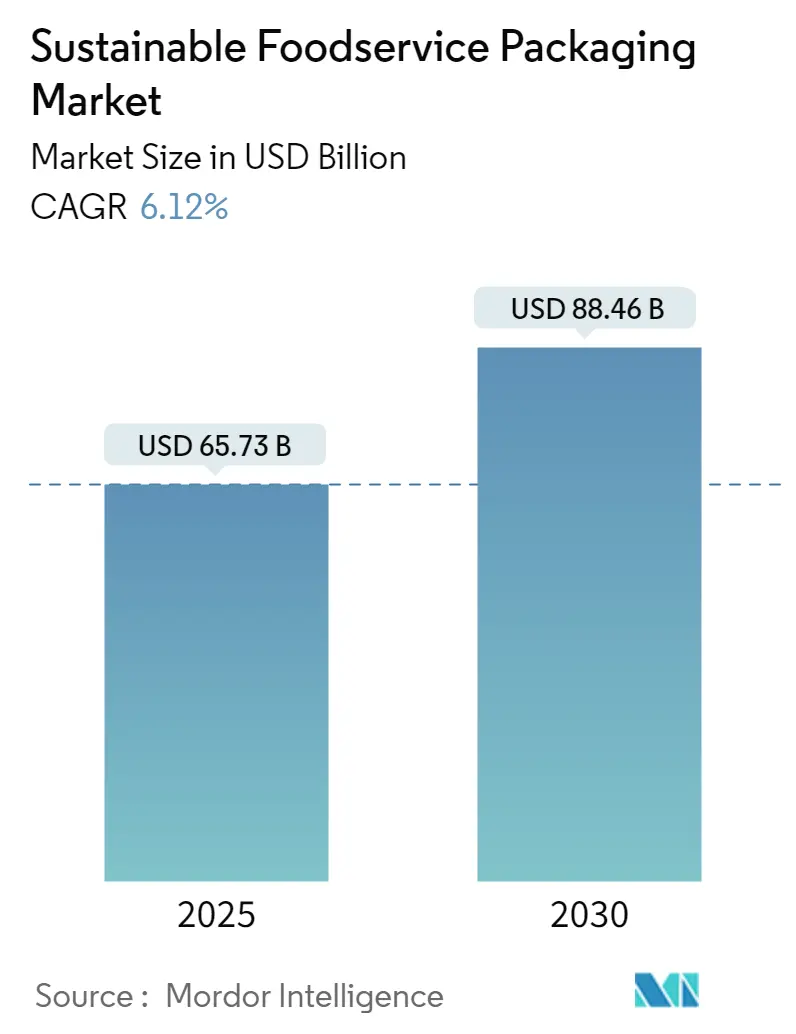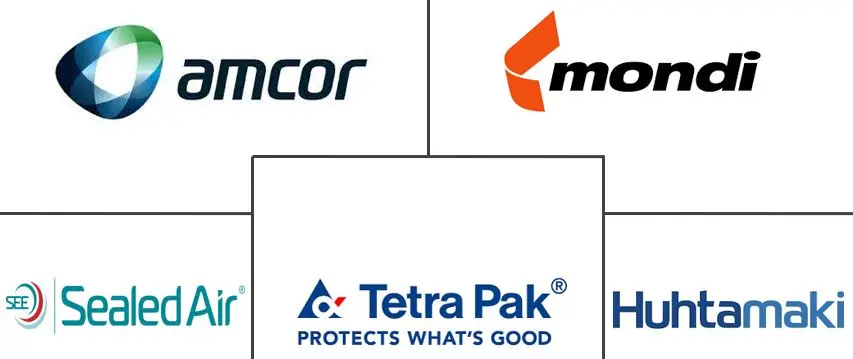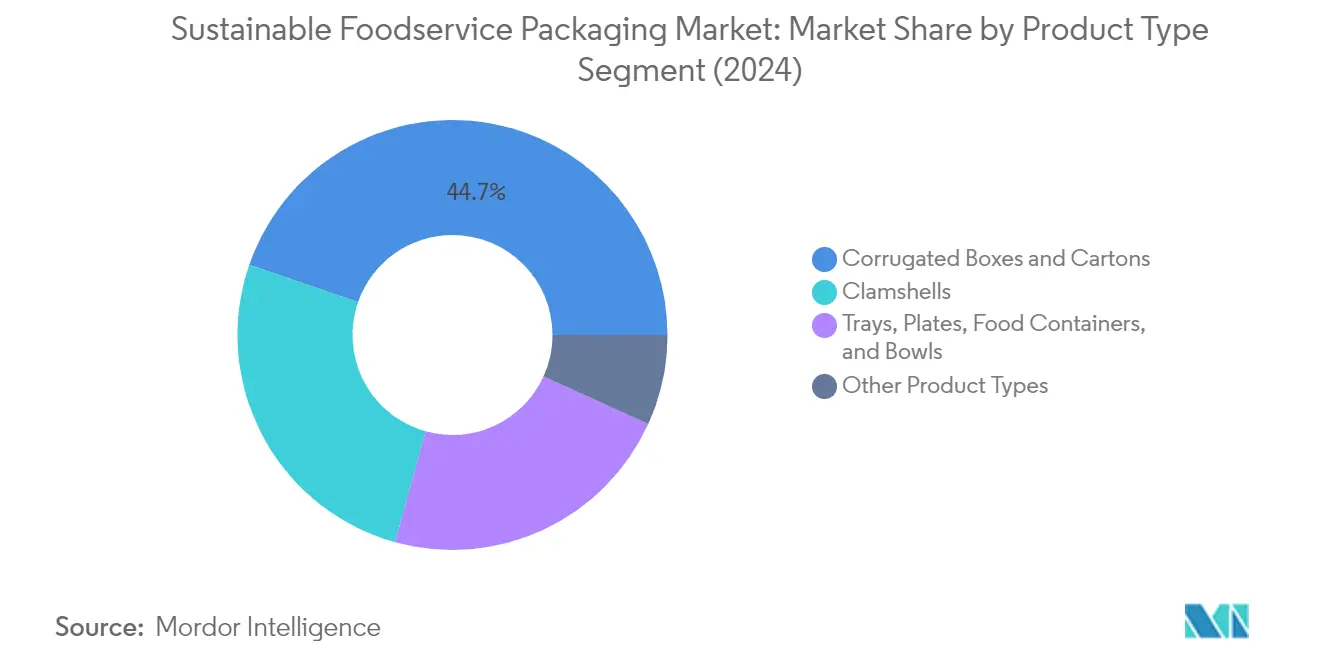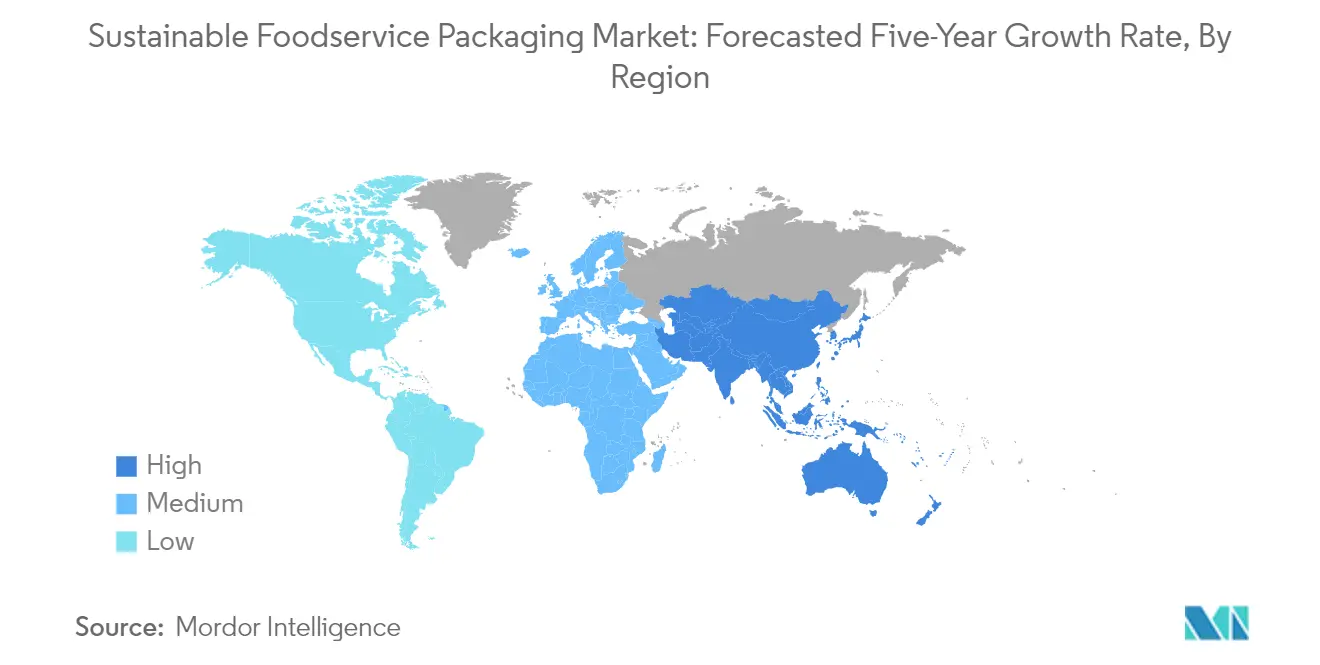
| Study Period | 2019 - 2030 |
| Market Size (2025) | USD 65.73 Billion |
| Market Size (2030) | USD 88.46 Billion |
| CAGR (2025 - 2030) | 6.12 % |
| Fastest Growing Market | Asia Pacific |
| Largest Market | North America |
| Market Concentration | Low |
Major Players
*Disclaimer: Major Players sorted in no particular order |
Sustainable Foodservice Packaging Market Analysis
The Sustainable Foodservice Packaging Market size is worth USD 65.73 Billion in 2025, growing at an 6.12% CAGR and is forecast to hit USD 88.46 Billion by 2030.
The sustainable foodservice packaging industry is experiencing significant transformation driven by evolving regulatory landscapes and technological advancements. Governments worldwide are implementing stringent regulations to combat packaging waste, with notable initiatives like the Indian government's nationwide ban on single-use plastics implemented in July 2022. According to the Environmental Protection Agency, the United States alone generates approximately 80 million tons of packaging waste annually, with nearly half attributed to foodservice packaging products. This has prompted major industry players to accelerate their transition towards more sustainable alternatives, focusing on innovative materials and production processes that minimize environmental impact.
The industry is witnessing a surge in research and development investments, particularly in materials science and sustainable design capabilities. Nestlé has demonstrated this commitment by establishing a CHF 250 million sustainable packaging venture fund to invest in start-up companies focusing on innovative packaging solutions, including new materials, refill systems, and recycling technologies. Companies are increasingly adopting circular economy principles, exemplified by Berry Global Group's commitment to incorporate 30% circular plastics in its fast-moving consumer goods packaging by 2030, surpassing their previous target of 10% post-consumer recycled resin by 2025.
The foodservice packaging landscape is being reshaped by changing consumer behaviors and urbanization trends. The rise of modern work cultures has significantly influenced packaging demands, with the National Coffee Association reporting that 48% of survey respondents utilize drive-through services for coffee purchases, highlighting the need for sustainable food packaging solutions. This shift in consumption patterns has led to increased innovation in recyclable and biodegradable packaging materials, particularly for quick-service restaurants and coffee chains.
The industry is experiencing a notable shift towards vertical integration and strategic partnerships to enhance sustainability initiatives. Major packaging manufacturers are investing in advanced manufacturing facilities and forming collaborations with material scientists and environmental organizations to develop next-generation sustainable foodservice packaging solutions. These partnerships are focusing on creating packaging materials that not only meet environmental standards but also maintain food safety and quality requirements, while addressing challenges related to cost-effectiveness and scalability in production processes. The emphasis is increasingly on developing solutions that can be implemented across the entire value chain, from manufacturing to disposal or recycling.
Sustainable Foodservice Packaging Market Trends
Shift in Consumer Preferences Toward Recyclable and Eco-Friendly Materials
The increasing environmental consciousness among consumers has become a significant driver for sustainable food packaging adoption. Traditional packaging materials, particularly single-use plastics, have created substantial environmental concerns, with studies showing that plastic packaging alone contributes to 43% of pollution in India. This growing awareness has prompted major foodservice chains to make bold commitments toward sustainable packaging solutions. For instance, in 2023, KFC India has been expanding its 'KFConscious' initiative, which focuses on using environmentally friendly materials across its outlets, demonstrating the industry's response to changing consumer preferences.
The shift in consumer behavior has catalyzed partnerships and innovations in sustainable foodservice packaging solutions. Major industry players like Yum! Brands have formed strategic alliances with organizations such as the NextGen Consortium to advance sustainable foodservice packaging solutions. These collaborations are driving the development of new recyclable and eco-friendly packaging alternatives, including paper-based containers, biodegradable utensils, and compostable packaging materials. Companies like CHUK have emerged as significant players in the compostable foodservice ware segment, partnering with quick commerce firms to make sustainable packaging more accessible to end consumers, reflecting the market's response to evolving consumer preferences.
Online Food Ordering Services Will Drive the Market
The exponential growth in online food delivery services has created a substantial demand for eco-friendly food service packaging solutions. The rise of digital ordering platforms has led to increased consumption of packaging materials, prompting foodservice providers to seek more environmentally responsible packaging options. Major quick-service restaurants are implementing comprehensive sustainability strategies in their delivery packaging, with companies like Pizza Hut, Taco Bell, and KFC committing to making all their packaging recyclable, compostable, or reusable by 2025. This transformation in the delivery sector has become a crucial driver for innovations in sustainable packaging solutions.
The integration of sustainable packaging in the online food delivery ecosystem has fostered new partnerships and technological advancements. For example, Indian Railways and Air India have announced initiatives to replace plastic packaging with eco-friendly paper alternatives and wooden cutlery, demonstrating the widespread adoption of sustainable packaging solutions across various foodservice channels. Companies like Eka Global are responding to this trend by investing in new manufacturing facilities focused on green products under the circular economy concept, with plans to become one of the world's top five longevity packaging producers. These developments indicate how the growth of online food ordering services is catalyzing investments and innovations in sustainable packaging solutions.
Segment Analysis: By Product Type
Corrugated Boxes and Cartons Segment in Sustainable Foodservice Packaging Market
The Corrugated Boxes and Cartons segment dominates the foodservice packaging market, commanding approximately 45% market share in 2024. This segment's leadership position is driven by the increasing adoption of corrugated packaging solutions across quick-service restaurants and food delivery services. The segment's growth is further bolstered by its superior characteristics, including non-reactive properties, making it an ideal medium for packaging, transporting, and storing food for extended periods. Major food service chains and restaurants are increasingly choosing corrugated boxes and cartons due to their recyclability, cost-effectiveness, and ability to maintain food quality. The segment is also witnessing significant technological innovations in terms of improved barrier properties and sustainable manufacturing processes, making it the fastest-growing segment with a robust growth trajectory through 2024-2029.

Remaining Segments in Sustainable Foodservice Packaging Market
The market's other significant segments include Clamshells, which play a crucial role in protecting food from air pollutants and maintaining freshness, and Trays, Plates, Food Containers, and Bowls, which are essential for various foodservice applications. The Clamshells segment has gained prominence due to its versatility in different food packaging applications, particularly in the protein markets and fresh food segments. The Trays, Plates, Food Containers, and Bowls segment continues to evolve with innovations in bio-based materials and compostable solutions. These segments are witnessing continuous innovation in materials science and design capabilities, with manufacturers focusing on developing more sustainable alternatives to traditional plastic-based products. The Other Product Types segment, including cutlery, stirrers, and straws, though smaller in market share, remains crucial for completing the sustainable food packaging ecosystem.
Segment Analysis: By End Users
QSR Segment in Sustainable Foodservice Packaging Market
The Quick Service Restaurant (QSR) segment dominates the sustainable packaging food industry, commanding approximately 38% of the market share in 2024. This segment's leadership position is driven by major QSR chains' commitment to sustainable packaging solutions and increasing consumer demand for eco-friendly takeaway options. Many quick-service restaurants are actively transitioning from traditional packaging materials to more environmentally conscious alternatives, with several major chains pledging to achieve 100% sustainable packaging goals. The segment's growth is further propelled by the rising adoption of online food delivery services and the increasing awareness among QSR operators about their environmental responsibilities. Additionally, QSR chains are investing significantly in innovative sustainable packaging solutions that maintain food quality while reducing environmental impact, making this segment both the largest and the fastest-growing with a robust growth trajectory expected through 2029.
Full-Service Restaurants Segment in Sustainable Foodservice Packaging Market
The full-service restaurants segment represents a significant portion of the sustainable foodservice packaging market, with a strong focus on premium and environmentally conscious packaging solutions. These establishments are increasingly adopting sustainable packaging options for their takeaway and delivery services, driven by growing consumer awareness and regulatory pressures. Full-service restaurants are particularly investing in high-quality, sustainable packaging solutions that maintain the premium dining experience while adhering to environmental standards. The segment is witnessing increased adoption of biodegradable containers, compostable packaging materials, and innovative designs that minimize waste while maximizing food protection and presentation quality. This trend is further supported by the growing preference for fine dining takeaway options and the increasing demand for sustainable food packages in upscale restaurants.
Remaining Segments in End Users Market Segmentation
The remaining segments in the sustainable foodservice packaging market include institutional, hospitality, and other end users, each serving distinct market needs. The institutional segment, encompassing educational institutions and offices, focuses on bulk packaging solutions with emphasis on recyclability and waste reduction. The hospitality segment, including hotels and catering services, demands premium sustainable packaging solutions that maintain food quality while adhering to environmental standards. Other end users, such as mobile restaurants and food service vehicles, contribute to market growth through their increasing adoption of eco-friendly packaging alternatives. These segments collectively drive innovation in sustainable packaging solutions, with each addressing specific requirements in terms of durability, presentation, and environmental impact.
Sustainable Foodservice Packaging Market Geography Segment Analysis
Sustainable Foodservice Packaging Market in North America
The North American sustainable foodservice packaging market holds approximately 25% market share in 2024, driven by rising consumer awareness and favorable government regulations. The region's market is characterized by a strong presence of major packaging players like Sealed Air Corporation and WestRock Company, who are continuously investing in advanced packaging technologies to boost productivity and enable greater packaging customization. The United States leads the regional market with a robust infrastructure for recycling and waste management, supported by stringent environmental regulations. Quick-service restaurants and food delivery services in the region are rapidly transitioning towards sustainable packaging alternatives, creating significant market opportunities. The region demonstrates a strong interest in providing packaging solutions that are viewed as sustainable, encouraging companies to invest in new manufacturing capabilities and innovative materials. The presence of sophisticated retail infrastructure and environmentally conscious consumers further strengthens the market dynamics. Additionally, the region's focus on reducing packaging waste through innovative solutions and circular economy initiatives continues to shape the sustainable packaging market landscape.

Sustainable Foodservice Packaging Market in Europe
The European sustainable foodservice packaging market has demonstrated robust growth of approximately 6% during 2019-2024, establishing itself as a pioneer in sustainable packaging innovations. The region's market is characterized by stringent environmental regulations and ambitious sustainability targets set by the European Union. Food service providers across Europe are increasingly adopting eco-friendly packaging solutions, driven by growing consumer awareness and regulatory pressures. The market benefits from advanced recycling infrastructure and a strong commitment to circular economy principles across European nations. The region showcases significant innovations in biodegradable and compostable packaging materials, particularly in countries like Germany, France, and the United Kingdom. Local manufacturers are investing heavily in research and development to create novel sustainable packaging solutions. The presence of sophisticated waste management systems and high environmental consciousness among consumers further strengthens the market dynamics. Moreover, the collaboration between packaging manufacturers, food service providers, and research institutions continues to drive innovation in sustainable packaging solutions.
Sustainable Foodservice Packaging Market in Asia-Pacific
The Asia-Pacific foodservice packaging market is projected to grow at approximately 7% during 2024-2029, emerging as the most dynamic region in the global market. The region's rapid urbanization and changing consumer preferences are driving significant transformations in food service packaging. Countries like China, Japan, and India are witnessing increased adoption of sustainable packaging solutions across various food service segments. The market is characterized by growing environmental awareness among consumers and progressive government policies promoting sustainable packaging alternatives. Local manufacturers are increasingly investing in eco-friendly packaging technologies and materials to meet the rising demand. The region's large population base and growing middle class create substantial opportunities for market expansion. The emergence of innovative start-ups focusing on sustainable packaging solutions adds dynamism to the market. Furthermore, the strong presence of quick-service restaurants and growing food delivery services continues to drive demand for sustainable packaging solutions. The region also benefits from technological advancements and increasing investments in recycling infrastructure.
Sustainable Foodservice Packaging Market in Latin America
The Latin American food service packaging market is experiencing significant transformation driven by increasing environmental consciousness and regulatory changes. The region demonstrates growing adoption of eco-friendly packaging solutions, particularly in countries like Brazil and Mexico. Local manufacturers are developing innovative sustainable packaging solutions using locally available materials and resources. The market is characterized by increasing investments in recycling infrastructure and growing awareness about environmental conservation. Quick-service restaurants and food delivery services in the region are gradually transitioning towards sustainable packaging alternatives. The presence of large agricultural sectors provides opportunities for developing bio-based packaging solutions. Consumer awareness about environmental issues is steadily increasing, creating demand for sustainable packaging options. Furthermore, collaborations between international and local players are helping to introduce advanced sustainable packaging technologies in the region.
Sustainable Foodservice Packaging Market in Middle East and Africa
The Middle East and African service packaging market growth is witnessing steady growth driven by increasing urbanization and changing consumer preferences. The region is gradually embracing sustainable packaging solutions, particularly in developed markets like the UAE and Saudi Arabia. Growing environmental awareness and government initiatives promoting sustainability are reshaping the market landscape. The food delivery sector's expansion, particularly in major urban centers, is creating new opportunities for sustainable packaging solutions. Local manufacturers are increasingly focusing on developing eco-friendly alternatives to traditional packaging materials. The market is characterized by growing investments in recycling infrastructure and increasing adoption of international sustainability standards. Rising tourism and hospitality sectors in the region are driving demand for sustainable food service packaging solutions. Furthermore, international players are expanding their presence in the region, bringing advanced sustainable packaging technologies and solutions.
Sustainable Foodservice Packaging Industry Overview
Top Companies in Sustainable Foodservice Packaging Market
The sustainable food packaging companies market is characterized by the strong presence of established players like Amcor, Mondi, Sealed Air, Tetra Pak, and Huhtamaki, who are driving innovation through significant R&D investments. These companies are actively developing next-generation recyclable and biodegradable packaging solutions while modernizing their manufacturing facilities to improve operational efficiency. Strategic partnerships with research institutions and technology providers are enabling faster product development cycles and enhanced sustainability credentials. Companies are expanding their geographical footprint through targeted acquisitions in emerging markets while simultaneously investing in facility upgrades across existing locations. The focus remains on developing packaging solutions that align with circular economy principles while meeting stringent food safety and quality requirements.
Consolidation and Innovation Drive Market Growth
The market structure exhibits a mix of global conglomerates and specialized packaging manufacturers, with larger players leveraging their extensive R&D capabilities and distribution networks to maintain market leadership. Global players are increasingly acquiring regional specialists to expand their sustainable packaging portfolio and gain access to local markets, particularly in emerging economies. The industry is witnessing significant consolidation as companies seek to achieve economies of scale and enhance their technological capabilities through strategic acquisitions and joint ventures.
The competitive dynamics are shaped by increasing pressure from environmentally conscious consumers and stringent regulations around single-use plastics, driving companies to invest in sustainable alternatives. Market leaders are focusing on vertical integration to maintain better control over their supply chains and ensure consistent quality of sustainable materials. Regional players are carving out niches by developing innovative solutions for specific end-user segments while leveraging their understanding of local market requirements and regulations.
Innovation and Adaptability Key to Success
Success in the sustainable foodservice packaging industry market increasingly depends on companies' ability to innovate while maintaining cost competitiveness and meeting evolving regulatory requirements. Market incumbents are strengthening their position through continuous investment in research and development, focusing on developing packaging solutions that offer improved recyclability and biodegradability without compromising functionality. Companies are also expanding their sustainable material sourcing capabilities and establishing strategic partnerships with recycling infrastructure providers to create closed-loop systems.
New entrants and smaller players are finding opportunities by focusing on specific market segments and developing innovative solutions that address unique customer needs. The ability to adapt quickly to changing regulations and consumer preferences while maintaining product quality and competitive pricing is becoming crucial for success. Companies are increasingly investing in consumer education and transparency initiatives to build brand trust and loyalty. The development of region-specific strategies and products, considering local recycling infrastructure and regulations, is becoming essential for both market leaders and challengers. Leading sustainable food packaging companies are setting benchmarks in this regard.
Sustainable Foodservice Packaging Market Leaders
-
Amcor Plc
-
Mondi PLC
-
Sealed Air Corporation
-
Tetra Pak International SA
-
Huhtamaki oyj
- *Disclaimer: Major Players sorted in no particular order

Sustainable Foodservice Packaging Market News
- July 2024: Vytal, a Cologne-based company specializing in software-enabled reusable packaging solutions, secured EUR 6.2 million in growth financing. The funding was led by Emerald Technology's Sustainable Packaging Innovation Fund, with further contributions from Ventis, alongside continued support from existing backers Kiko Ventures, Grazia Equity, and Rubio. This financial injection strengthens Vytal's market position and reaffirms its commitment to advancing a circular economy through innovative technology and data-driven strategies.
- April 2024: Uber Eats, a food delivery service provider, in partnership with DeliverZero, expanded its reusable packaging pilot programs to the West Coast of the United States.
- March 2024: Sabert Corporation, a leading global manufacturer specializing in sustainable food packaging, unveiled its latest offering: the Earthtel r-PRO line. This new line features round bowls and containers crafted from Sabert's exclusive polypropylene blend. Notably, this blend incorporates 25% post-consumer recycled content (PCR), ensuring innovation and sustainability. Sabert's commitment to eco-friendliness shines through, as the entire Earthtel r-PRO collection is not only 100% recyclable but also aligns with the stringent APR guidelines for recyclability.
Sustainable Foodservice Packaging Market Report - Table of Contents
1. INTRODUCTION
- 1.1 Study Assumptions and Market Definition
- 1.2 Scope of the Study
2. RESEARCH METHODOLOGY
3. EXECUTIVE SUMMARY
4. MARKET INSIGHTS
- 4.1 Market Overview
- 4.2 Industry Value Chain Analysis
-
4.3 Industry Attractiveness - Porter's Five Forces Analysis
- 4.3.1 Bargaining Power of Suppliers
- 4.3.2 Bargaining Power of Buyers
- 4.3.3 Threat of New Entrants
- 4.3.4 Degree of Competition
- 4.3.5 Threat of Substitutes
- 4.4 Industry Ecosystem Analysis
- 4.5 Assessment of the Impact of Microeconomic Factors on the Industry
5. MARKET DYNAMICS
-
5.1 Market Drivers
- 5.1.1 Online Food Ordering Services Will Drive the Market
- 5.1.2 Shift in Consumer Preferences Toward Recyclable and Eco-friendly Materials
-
5.2 Market Restraints
- 5.2.1 The High Recycling Cost for the Materials Used for the Sustainable Foodservice Packaging Might Hinder the Growth of the Market
6. MARKET SEGMENTATION
-
6.1 By Product Type
- 6.1.1 Corrugated Boxes and Cartons
- 6.1.2 Trays, Plates, Food Containers, and Bowls
- 6.1.3 Clamshells
- 6.1.4 Other Product Types
-
6.2 By End Users
- 6.2.1 Quick Service Restaurants
- 6.2.2 Full Service Restaurants
- 6.2.3 Institutional
- 6.2.4 Hospitality
- 6.2.5 Other End Users
-
6.3 By Geography
- 6.3.1 North America
- 6.3.1.1 United States
- 6.3.1.2 Canada
- 6.3.2 Europe
- 6.3.2.1 United Kingdom
- 6.3.2.2 Germany
- 6.3.2.3 Rest of Europe
- 6.3.3 Asia-Pacific
- 6.3.3.1 China
- 6.3.3.2 Japan
- 6.3.3.3 India
- 6.3.3.4 Rest of Asia-Pacific
- 6.3.4 Latin America
- 6.3.5 Middle East & Africa
- 6.3.6
7. COMPETITIVE LANDSCAPE
-
7.1 Company Profiles*
- 7.1.1 Amcor PLC
- 7.1.2 Mondi PLC
- 7.1.3 Sealed Air Corporation
- 7.1.4 Tetra Pak International SA
- 7.1.5 Huhtamaki Oyj
- 7.1.6 Winpak Limited
- 7.1.7 Amhil North America
- 7.1.8 Sonoco Products Company
- 7.1.9 WestRock Company
- 7.1.10 Dart Container Corporation
8. INVESTMENT ANALYSIS
9. FUTURE OF THE MARKET
Sustainable Foodservice Packaging Industry Segmentation
The study aims to analyze and understand the packaging automation market's current growth, opportunities, and challenges. The scope of market analysis is segmented by product type (corrugated boxes and cartons, trays, plates, food containers and bowls, clamshells, and other product types), end user (quick-service restaurants, full-service restaurants, institutional, hospitality, and other end users), and geography (North America, Europe, Asia-Pacific, Latin America, and Middle East and Africa). The market sizes and forecasts are provided in terms of value in (USD) for all the above segments.
| By Product Type | Corrugated Boxes and Cartons | ||
| Trays, Plates, Food Containers, and Bowls | |||
| Clamshells | |||
| Other Product Types | |||
| By End Users | Quick Service Restaurants | ||
| Full Service Restaurants | |||
| Institutional | |||
| Hospitality | |||
| Other End Users | |||
| By Geography | North America | United States | |
| Canada | |||
| Europe | United Kingdom | ||
| Germany | |||
| Rest of Europe | |||
| Asia-Pacific | China | ||
| Japan | |||
| India | |||
| Rest of Asia-Pacific | |||
| Latin America | |||
| Middle East & Africa | |||
Sustainable Foodservice Packaging Market Research FAQs
How big is the Sustainable Foodservice Packaging Market?
The Sustainable Foodservice Packaging Market size is worth USD 65.73 billion in 2025, growing at an 6.12% CAGR and is forecast to hit USD 88.46 billion by 2030.
What is the current Sustainable Foodservice Packaging Market size?
In 2025, the Sustainable Foodservice Packaging Market size is expected to reach USD 65.73 billion.
Which is the fastest growing region in Sustainable Foodservice Packaging Market?
Asia Pacific is estimated to grow at the highest CAGR over the forecast period (2025-2030).
Which region has the biggest share in Sustainable Foodservice Packaging Market?
In 2025, the North America accounts for the largest market share in Sustainable Foodservice Packaging Market.
What years does this Sustainable Foodservice Packaging Market cover, and what was the market size in 2024?
In 2024, the Sustainable Foodservice Packaging Market size was estimated at USD 61.71 billion. The report covers the Sustainable Foodservice Packaging Market historical market size for years: 2019, 2020, 2021, 2022, 2023 and 2024. The report also forecasts the Sustainable Foodservice Packaging Market size for years: 2025, 2026, 2027, 2028, 2029 and 2030.
Our Best Selling Reports
Sustainable Foodservice Packaging Market Research
Mordor Intelligence provides a comprehensive analysis of the sustainable foodservice packaging market. We leverage decades of expertise in food service packaging research and consulting. Our extensive report examines the evolving landscape of foodservice packaging solutions. It focuses particularly on eco-friendly food service packaging trends and innovations. The analysis covers sustainable food packaging companies across global markets. It offers detailed insights into developments in sustainability in food service industry and emerging food service sustainability solutions.
Stakeholders in the sustainable foodservice sector will benefit from our thorough examination of sustainable food service packaging implementations and technologies. The report, available as an easy-to-download PDF, provides valuable insights into green food service packaging initiatives and the dynamics of the compostable foodservice packaging market. Our analysis supports decision-makers in the foodservice packaging industry with actionable intelligence on quick service packaging trends and the growth of the service packaging market. It also addresses crucial aspects of sustainability in food packaging and practices for environmental sustainability food packaging.




